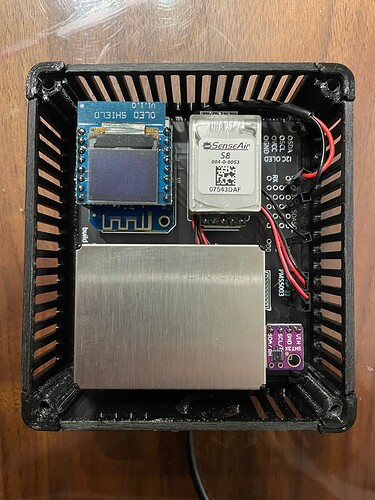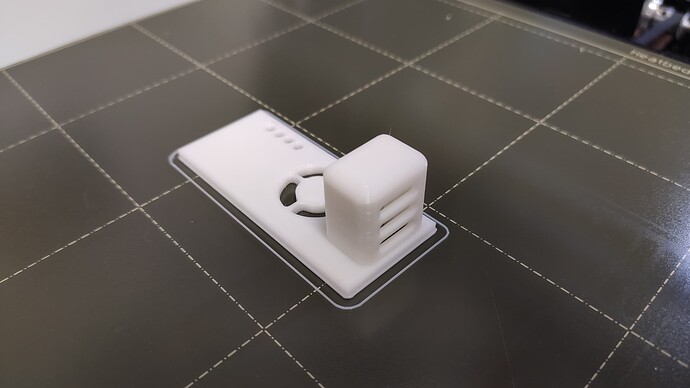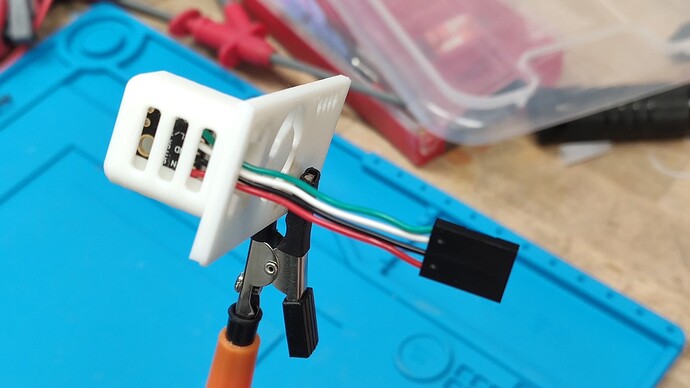My Airgradient project is finally finished. I made some adjustments that I would like to share with you.
- The air quality index (AQI) is displayed in Home Assistant and is calculated based on the values of the CO2 sensor and the PM sensor.
- I have built in a status RGB LED (WS2812B) that indicates the status of the Air Quality Index with three colors: green, orange and red. This LED is connected to GPIO15.
- The life of the PMS5003 sensor has been extended by using the SET functionality. See my other article: Extending the life span of the PMS5003 sensor for more information.
- I used the design from ttielemans for the case. Instead of connecting the power directly to the ESP module, it is fed into the back of the housing via a USB cable.
The project runs on ESPHome software. Below the code:
# Instructions: https://esphome.io/guides/getting_started_hassio.html
esphome:
name: airgradient
esp8266:
board: d1_mini
# Enable logging
logger:
# Enable Home Assistant API
api:
password: !secret API_Password
ota:
safe_mode: true
password: !secret OTA_Password
# https://esphome.io/components/wifi.html
wifi:
ssid: !secret wifi_ssid
password: !secret wifi_password
fast_connect: true
manual_ip:
static_ip: 192.168.3.12
gateway: 192.168.3.1
subnet: 255.255.255.0
captive_portal:
# Configuration for AirGradient DIY v2 device
# https://www.esphome-devices.com/devices/AirGradient-DIY/
# https://esphome.io/components/uart.html#uart
uart:
- rx_pin: D4
tx_pin: D3
baud_rate: 9600
id: senseair_s8_uart
- rx_pin: D5
tx_pin: D6
baud_rate: 9600
id: pms5003_uart
i2c:
sda: D2
scl: D1
sensor:
# https://esphome.io/components/sensor/pmsx003.html?highlight=pms5003
- platform: pmsx003
type: PMSX003
uart_id: pms5003_uart
pm_1_0:
name: "Airgradient PM <1.0µm"
id: pm1
filters:
- sliding_window_moving_average:
window_size: 30
send_every: 30
pm_2_5:
name: "Airgradient PM <2.5µm"
id: pm2_5
filters:
- sliding_window_moving_average:
window_size: 30
send_every: 30
pm_10_0:
name: "Airgradient PM <10.0µm"
id: pm10
filters:
- sliding_window_moving_average:
window_size: 30
send_every: 30
# https://esphome.io/components/sensor/senseair.html
- platform: senseair
co2:
name: "Airgradient CO2"
id: co2
update_interval: 60s
uart_id: senseair_s8_uart
# https://esphome.io/components/sensor/sht3xd.html?highlight=sht31
- platform: sht3xd
temperature:
name: "Airgradient Temperature"
id: temp
filters:
- offset: -1.5
humidity:
name: "Airgradient Humidity"
id: humidity
filters:
- offset: +3
address: 0x44
update_interval: 60s
# The WHO guidelines work with 24-hour averages of the PM2.5 and PM10 sensors
- platform: template
name: "Airgradient PM <2.5µm 24h average"
id: pm2_5_avg_24h
icon: mdi:chemical-weapon
unit_of_measurement: µg/m³
lambda: |-
return id(pm2_5).state;
update_interval: 60s
filters:
- sliding_window_moving_average:
window_size: 1440 # = 24 hours x 60 minutes
send_every: 1
on_value:
then:
- script.execute: update_aqi
- platform: template
name: "Airgradient PM <10.0µm 24h average"
id: pm10_avg_24h
icon: mdi:chemical-weapon
unit_of_measurement: µg/m³
lambda: |-
return id(pm10).state;
update_interval: 60s
filters:
- sliding_window_moving_average:
window_size: 1440 # = 24 hours x 60 minutes
send_every: 1
on_value:
then:
- script.execute: update_aqi
# A textual presentation of the AQI: goed, matig, slecht
text_sensor:
- platform: template
name: "Airgradient Air Quality Index"
id: aqi
icon: mdi:air-filter
# This script is called on every update of the relevant sensor values.
script:
- id: update_aqi
mode: restart
then:
# Bad if at least one of the sensor values is bad
- if:
condition:
or:
- sensor.in_range:
id: co2
above: 1199
- sensor.in_range:
id: pm2_5_avg_24h
above: 25
- sensor.in_range:
id: pm10_avg_24h
above: 50
then:
- text_sensor.template.publish:
id: aqi
state: Slecht
- script.execute: show_bad
else:
# Acceptable if at least one of the sensor values is acceptable
- if:
condition:
or:
- sensor.in_range:
id: co2
above: 899
- sensor.in_range:
id: pm2_5_avg_24h
above: 12
- sensor.in_range:
id: pm10_avg_24h
above: 25
then:
- text_sensor.template.publish:
id: aqi
state: Matig
- script.execute: show_acceptable
else:
# Otherwise good (all of the sensor values are good)
- text_sensor.template.publish:
id: aqi
state: Goed
- script.execute: show_good
# Configuration for showing AQI status with the RGB LED
- id: show_bad
then:
- light.turn_on:
id: status_led
brightness: 25%
red: 100%
green: 0%
blue: 0%
- id: show_acceptable
then:
- light.turn_on:
id: status_led
brightness: 25%
red: 100%
green: 60%
blue: 0%
- id: show_good
then:
- light.turn_on:
id: status_led
brightness: 25%
red: 0%
green: 100%
blue: 0%
display:
- platform: ssd1306_i2c
# https://esphome.io/components/display/ssd1306.html?highlight=display
model: "SSD1306 64x48"
id: oled_display
reset_pin: D0
address: 0x3C
rotation: 180
# rotation: 180 # Enable to 180 to flip screen around
pages:
- id: display_pm2
lambda: |-
it.print(0, 0, id(font1), "PM2,5");
it.printf(64, 24, id(font1), TextAlign::TOP_RIGHT, "%.0f",id(pm2_5).state);
- id: display_pm10
lambda: |-
it.print(0, 0, id(font1), "PM10");
it.printf(64, 24, id(font1), TextAlign::TOP_RIGHT, "%.0f",id(pm10).state);
- id: display_co2
lambda: |-
it.print(0, 0, id(font1), "CO2");
it.printf(64, 24, id(font1), TextAlign::TOP_RIGHT, "%.0f",id(co2).state);
- id: display_temp
lambda: |-
it.print(0, 0, id(font1), "°C");
it.printf(64, 24, id(font1), TextAlign::TOP_RIGHT, "%.1f",id(temp).state);
- id: display_humidity
lambda: |-
it.print(0, 0, id(font1), "HUM");
it.printf(64, 24, id(font1), TextAlign::TOP_RIGHT, "%.0f%%",id(humidity).state);
font:
# Font to use on the display
# Open Source font Liberation Sans by Red Hat
# https://www.dafont.com/liberation-sans.font
- file: './fonts/liberation_sans/LiberationSans-Regular.ttf'
id: font1
size: 22
interval:
- interval: 3s
# Cycle through page on display
then:
- display.page.show_next: oled_display
- component.update: oled_display
- interval: 120s
# Two-minute interval to extend the life span of the PMS5003 sensor
then:
- switch.turn_on: pms_set
- delay: 20s
- switch.turn_off: pms_set
switch:
- platform: gpio
# Switch for PMS5003 sensor
pin:
number: D7
id: pms_set
name: "Airgradient PMS5003 Switch"
light:
- platform: neopixelbus
type: GRB
variant: WS2812x
pin: GPIO15
num_leds: 1
name: "AQI Status LED"
id: status_led
@ Achim Haug @Achim_AirGradient and @Thor Tielemans @ttielemans: thanks for your ideas!




